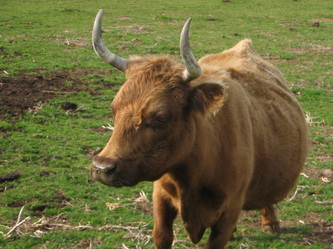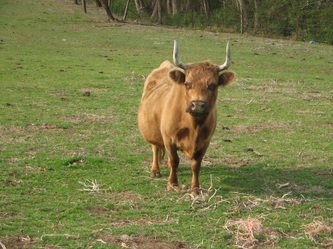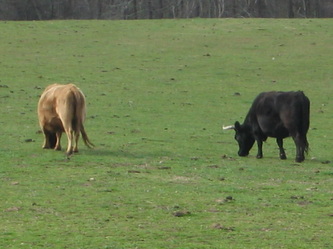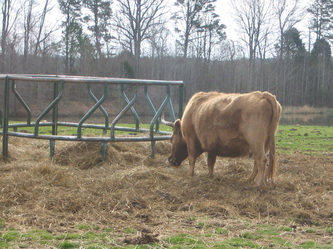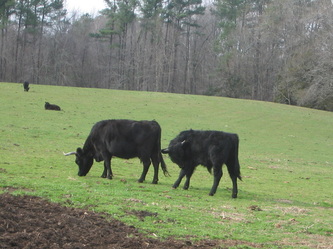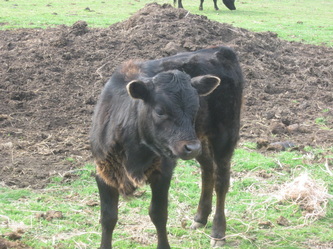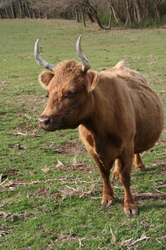Local vs. Industrial Beef Suppliers
by E
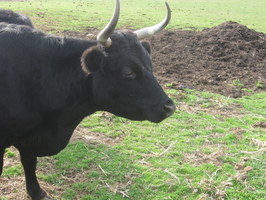
This article will examine two sides of the beef market. Woodcrest Farm is one example of local beef, and the example of non-local beef is most mass beef suppliers, not including happy beef, like Kobe beef.
Industrial beef suppliers use a form of mass slaughter, while many local beef suppliers do not kill a lot of their animals at one time. Industrial beef has to travel from far away, while local beef sales are more energy-efficient. They are closer, so the pollution from travel is less. Non-local beef uses a form of slaughtering called the double-rail slaughter system. In the double-rail slaughter system, the cattle are lined up. They have two legs across a rail and are sent down the rail to get shot in the head with a bolt. After they get shot in the head, they bleed to death. According to Michael Pollan’s Omnivore’s Dilemma, the double-rail slaughter system has a “5% ‘error rate,’ which means over the course of an hour, 20 cows that are killed by the double-rail slaughter system die a painful death.”
Woodcrest Farm in Hillsborough, NC, uses local meat butchers. They do not sell a lot of beef, but they use similar systems that other local farms use. Local meat butchers are butchers that are close to the farm. In the USA, the USDA requires that the animal is shocked unconscious and has their carotid artery cleaved. This means they have their throats slit. Also, before the cattle can be killed, they can’t be sick for health reasons. They have to be able to walk to their death. Allan Green, the owner and farmer at Woodcrest Farm, told me that some Kosher and Halal butchers bleed the animal out when the heart is still beating so the heart can “pump out all the blood in the animal before finally getting killed.” Kosher is a Jewish method where the animal is slaughtered as painlessly as possible and blessed by a butcher rabbi. Halal meat also has to be killed painlessly, but it is not blessed by a rabbi. It is an Islamic method.
Industrial beef suppliers use Jersey cattle because they are bigger, which means more beef. In non-local beef suppliers, the cattle are put in big areas that can hold almost one hundred cattle squeezed together. The cattle are fed corn, which messes up their immune system. In order to fix the problem, the industrial beef suppliers have to put chemicals in the beef to make it edible.
We visited Woodcrest Farm to experience what it was like to be a local farmer. Woodcrest Farm feeds their beef grass and hay, which is better for the animal and tastes better. Because they don’t have to put chemicals in the beef, the beef is better for you. They use smaller cattle called Dexter cattle. Dexter cattle are not used in industries because they are smaller. The Woodcrest Farm cattle keep their horns, which makes them feel better. You can tell that the cattle are healthy because their hips are flat. The Dexter cattle free roam in a huge field, which makes them pretty happy.
I learned a lot about beef, and it has really impacted my life. I will no longer eat industrial beef and have to eat organic. I believe in eating organic beef because it is not killed in a cruel way. This experience has really changed the way I eat beef. Local food is now a big way of life for me.
Industrial beef suppliers use a form of mass slaughter, while many local beef suppliers do not kill a lot of their animals at one time. Industrial beef has to travel from far away, while local beef sales are more energy-efficient. They are closer, so the pollution from travel is less. Non-local beef uses a form of slaughtering called the double-rail slaughter system. In the double-rail slaughter system, the cattle are lined up. They have two legs across a rail and are sent down the rail to get shot in the head with a bolt. After they get shot in the head, they bleed to death. According to Michael Pollan’s Omnivore’s Dilemma, the double-rail slaughter system has a “5% ‘error rate,’ which means over the course of an hour, 20 cows that are killed by the double-rail slaughter system die a painful death.”
Woodcrest Farm in Hillsborough, NC, uses local meat butchers. They do not sell a lot of beef, but they use similar systems that other local farms use. Local meat butchers are butchers that are close to the farm. In the USA, the USDA requires that the animal is shocked unconscious and has their carotid artery cleaved. This means they have their throats slit. Also, before the cattle can be killed, they can’t be sick for health reasons. They have to be able to walk to their death. Allan Green, the owner and farmer at Woodcrest Farm, told me that some Kosher and Halal butchers bleed the animal out when the heart is still beating so the heart can “pump out all the blood in the animal before finally getting killed.” Kosher is a Jewish method where the animal is slaughtered as painlessly as possible and blessed by a butcher rabbi. Halal meat also has to be killed painlessly, but it is not blessed by a rabbi. It is an Islamic method.
Industrial beef suppliers use Jersey cattle because they are bigger, which means more beef. In non-local beef suppliers, the cattle are put in big areas that can hold almost one hundred cattle squeezed together. The cattle are fed corn, which messes up their immune system. In order to fix the problem, the industrial beef suppliers have to put chemicals in the beef to make it edible.
We visited Woodcrest Farm to experience what it was like to be a local farmer. Woodcrest Farm feeds their beef grass and hay, which is better for the animal and tastes better. Because they don’t have to put chemicals in the beef, the beef is better for you. They use smaller cattle called Dexter cattle. Dexter cattle are not used in industries because they are smaller. The Woodcrest Farm cattle keep their horns, which makes them feel better. You can tell that the cattle are healthy because their hips are flat. The Dexter cattle free roam in a huge field, which makes them pretty happy.
I learned a lot about beef, and it has really impacted my life. I will no longer eat industrial beef and have to eat organic. I believe in eating organic beef because it is not killed in a cruel way. This experience has really changed the way I eat beef. Local food is now a big way of life for me.
